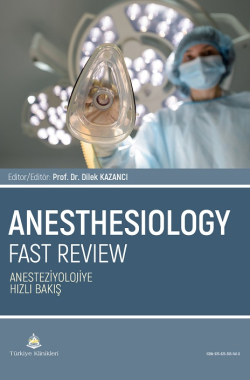RENAL PHYSIOLOGY
Seval Kılbasanlı
Ömer Halisdemir University, Faculty of Medicine, Department of Anesthesiology, Niğde, Türkiye
Kılbasanlı S. Renal Physiology. In: Kazancı D, editor. Anesthesiology Fast Review. 1st ed. Ankara: Türkiye Klinikleri; 2025. p.45-53.
ABSTRACT
- The kidneys play a crucial role in regulating body fluid balance, metabolic waste excretion, and acid-base homeostasis.
- Each kidney contains approximately 1 million nephrons, the functional units responsible for urine formation.
- Renal circulation accounts for 22% of cardiac output, with blood flow rates of approximately 1100 ml/min.
- The glomerular filtration rate (GFR) is a critical indicator of kidney function, with an average of 125 ml/min in healthy adults.
- The nephron’s reabsorption and secretion mechanisms maintain electrolyte balance and regulate the composition of the filtrate.
- Perioperative factors, including anesthesia, can impair renal function, leading to fluid imbalance and acute kidney injury.
- Anesthetic agents can cause both direct and indirect effects on renal perfusion and glomerular filtration.
- Maintaining renal function in perioperative management requires careful hemodynamic monitoring and fluid balance control.
- Autoregulatory mechanisms help stabilize GFR despite fluctuations in arterial pressure within certain limits.
- Research highlights the importance of a multidisciplinary approach to minimize renal complications during surgery and anesthesia.
Keywords: Kidney; Physiology; Anesthesia; Nephrons; Glomerular filtration rate
×
Kaynak Göster
Referanslar
- Butterworth JF IV, Mackey DC, Wasnick JD, eds. Morgan & Mikhail's Clinical Anesthesiology. 7th ed. McGraw-Hill Education; 2022. Accessed January 25, 2025. [Link]
- Widmaier EP, Raff H, Strang KT, eds. Vander's Human Physiology: The Mechanisms of Body Function. 15th ed. McGraw-Hill Education; 2019. Accessed January 25, 2025. [Link]
- Hall JE. Guyton and Hall Textbook of Medical Physiology. 14th ed. Elsevier; 2020. Accessed January 25, 2025. [Link]
- Agar E. Human Physiology. 1st ed. Istanbul Tıp Kitabevi; 2021. Accessed January 25, 2025. [Link]
- Barrett KE, Barman SM, Yuan J, Brooks HL. Ganong's Review of Medical Physiology. 26th ed. McGraw Hill Medical Books; 2019. Accessed January 25, 2025. [Link]
- Köylü H. Medical Physiology with Clinical Explanation. 4th ed. Ankara: Nobel Tıp Kitabevleri; 2020. Accessed January 25, 2025. [Link]
- Wilson LB, Kaplan P. USMLE Step 1 Lecture Notes 2018: Physiology. Kaplan Medical 2018. Accessed January 25, 2025. [Link]
- Costanzo L. Costanzo Physiology. 7th ed. Elsevier; 2021. Accessed January 25, 2025. [Link]
- Evers AS, Maze M, Kharasch ED, eds. Anesthetic Pharmacology: Physiologic Principles and Clinical Practice. 1st ed. Churchill Livingstone; 2004. Accessed January 25, 2025. [Link]
- Colson P, Ryckwaert F, Coriat P. Renin angiotensin system antagonists and anesthesia. Anesth Analg. 1999;89:1143. Accessed January 25, 2025. [Crossref]
- Gropper MA, Cohen NH, Eriksson LI, Fleisher LA, Leslie K, Wiener-Kronish JP, et al., eds. Miller's Anesthesia. 10th ed. Elsevier; 2022. Accessed January 25, 2025. [Link]

